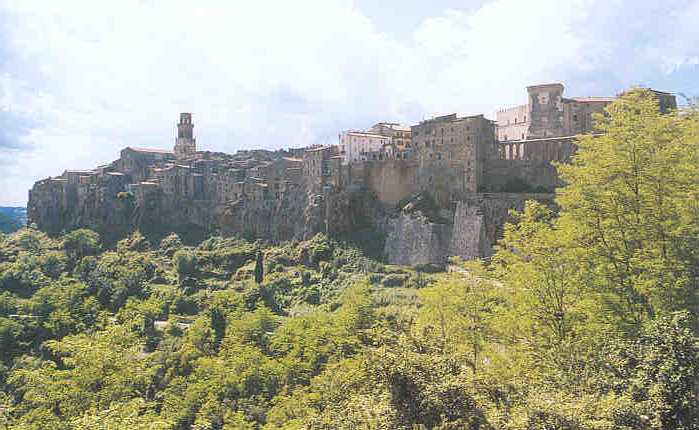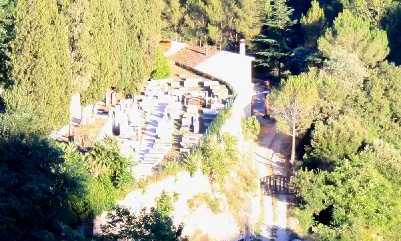Jewish Genealogy in Italy
Pitigliano - The little Jerusalem
Pitigliano, at the southernmost border of Tuscany, is geographically closer to Rome
than to Florence.
After the decree of the Pope of 1555, decree that forced the Jews into the ghettos in Rome and Ancona, many Jews of the Papal State escaped. Some of them simply crossed the border and stoped in the first safe, welcoming place.
Pitigliano became a destination also for the Tuscan Jews when the ghettos were established in Florence and Siena around 1570.
This country town was for some years a "land of refuge" where Jews could live in
peace. For this reason the town was called among the Tuscan Jews 'La Piccola Gerusalemme' (The Little Jerusalem).
This peace came to an end in 1608, when the Orsini family ceded Pitigliano the
to Medici family in exchange for the lands of Monte San Savino.
| As a result, in 1622 the Jews of Pitigliano were
forced into the ghetto and were required to wear distinctive badge (a red hat for men and
a red sign on the sleeve for women). The jewish community fought against these
discriminatory practices which were completely new to them: between 1635 and 1747
individual Jews asked to be exonerated by the authorities. The community was often taxed
to provide loans for the construction of special works.
Pitigliano, like all of the Grand Duchy of Tuscany, became part of the Lorraine family
dominion in 1738.
In 1799 the Jews of Pitigliano celebrated the arrival of Napoleon's troops. The gangs of
"Viva Maria" reached the town with the sackings of the ghetto and arrests.
|
|
 Pitigliano
Pitigliano |
The phenomenon of urban migration was very strong anong the Jews of Pitigliano, who left the town to move to Florence, specially when Firenze became the capital of Italy. It only
look a few years for the community to nearly cease to exist (see the table below). The memory of its past, however, did not disappear.
| Number of Jews in Pitigliano: |
| 1576 |
|
50 |
|
| 1608 |
|
110 |
|
| 1644 |
|
150 |
|
| 1672 |
|
180 |
|
| 1773 |
|
200 |
|
| 1841 |
|
359 |
|
| 1858 |
|
420 |
|
| 1860 |
|
260 |
|
| 1900 |
|
250 |
|
| 1938 |
|
70 |
|
| 1948 |
|
40 |
|
|
|
|
|
|
|
Resources of the 19th
century:
List of records that can be found for the Jews of Pitigliano:
| Births |
Matrimonies |
Dearths |
Other |
| 1815 - 1816 |
1815 - 1816 |
1815 - 1816 |
Census of 1841 |
| 1818 - 1835 |
1818 - 1850 |
|
|
| 1835 - 1850 |
1851 - 1858 |
1855-1865 |
Census of 1861 |
| 1853 - 1865 |
1857 - 1865 |
|
|
| 1865 - 2000 |
1865 - 2000 |
1865 - 2000 |
|
| Jewish Cemetery. The old pictoresque Jewish cemetery
is located at the base of the rock. The cemetery part carved in the tufa stone has been
recently restaurated. Please contact for
information on the tomb-stones. |
|
 |
Bibliography:
- Annie Sacerdoti, Guida al'Italia Ebraica, Marietti, Genova: 1986, English
transl. by Richard F. De Lossa, Guide to Jewish Italy, Israelowitz
Publishing, Brooklyn NY: 1989.
- Dora Liscia Bemporad and Anna Marcela Tedeschi Falco, Tuscany Jewish Itineraries:
Place, History and Art. Marsilio 1997.
- Roberto G. Salvadori, Breve storia degli ebrei toscani, Le Lettere, Firenze 1995.
Surnames of the Jews of Pitigliano :
Most frequent surnames found in documents of the 18th-19th centuries:
Ayò, Barroccia, Bechini, Bemporad, Cabibbe, Camerino, Capua,
Coen, Colombo, Console, Dina, Funaro, Gallichi
Lates, Lates, Levi, Montefiore, Moscati, Moscato, Nepi,
Nissin, Orvieti, Pace, Paggi, Pergola, Piazza
Sadun, Servi, Servo Servi, Sicchi, Sonnino, Sorani, Sorani,
Sorani, Spizzichino, Tedeschi, Urbino, Ventura, Vitali
© Isetta Masliouk 1997
 Pitigliano
Pitigliano